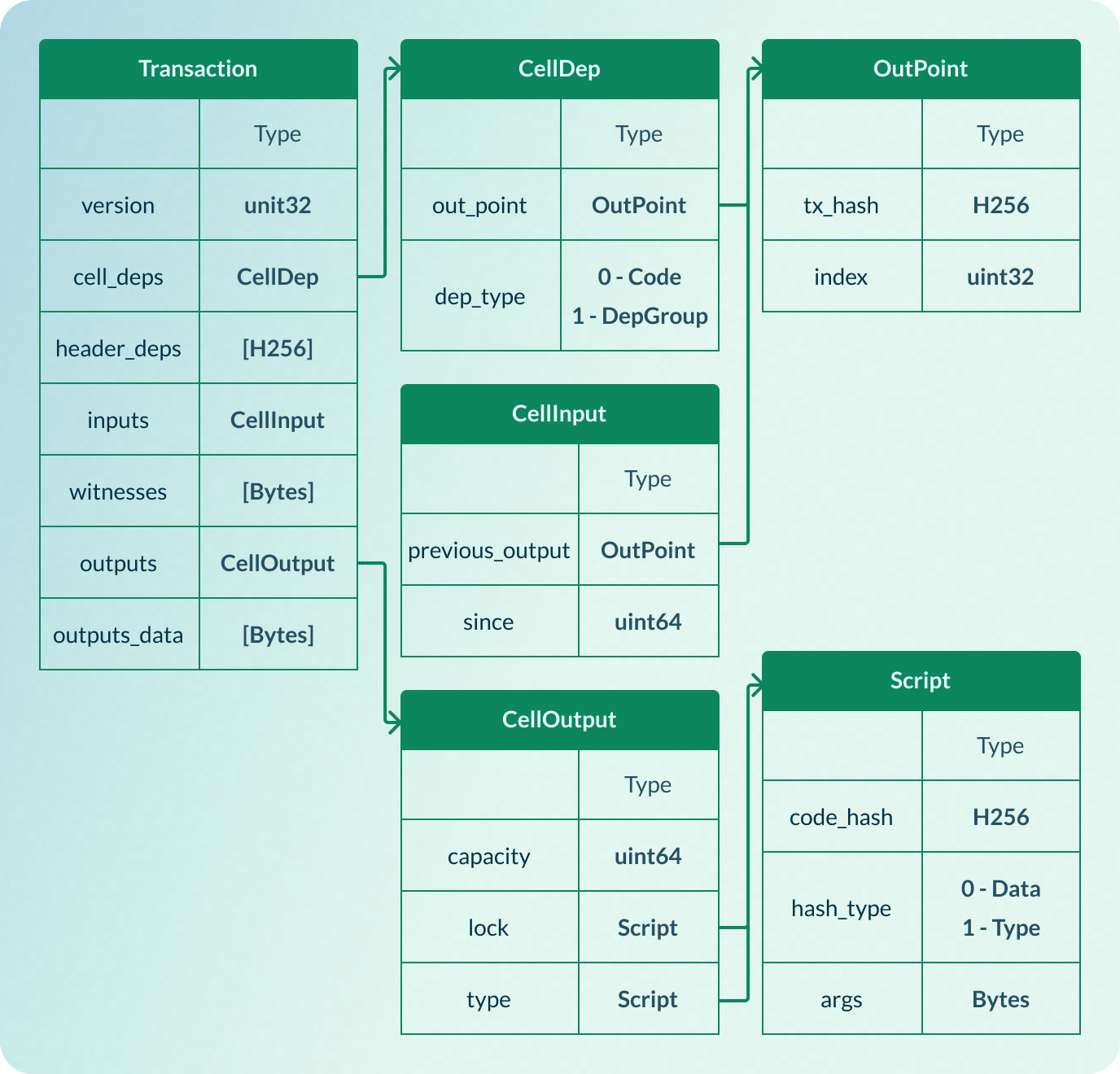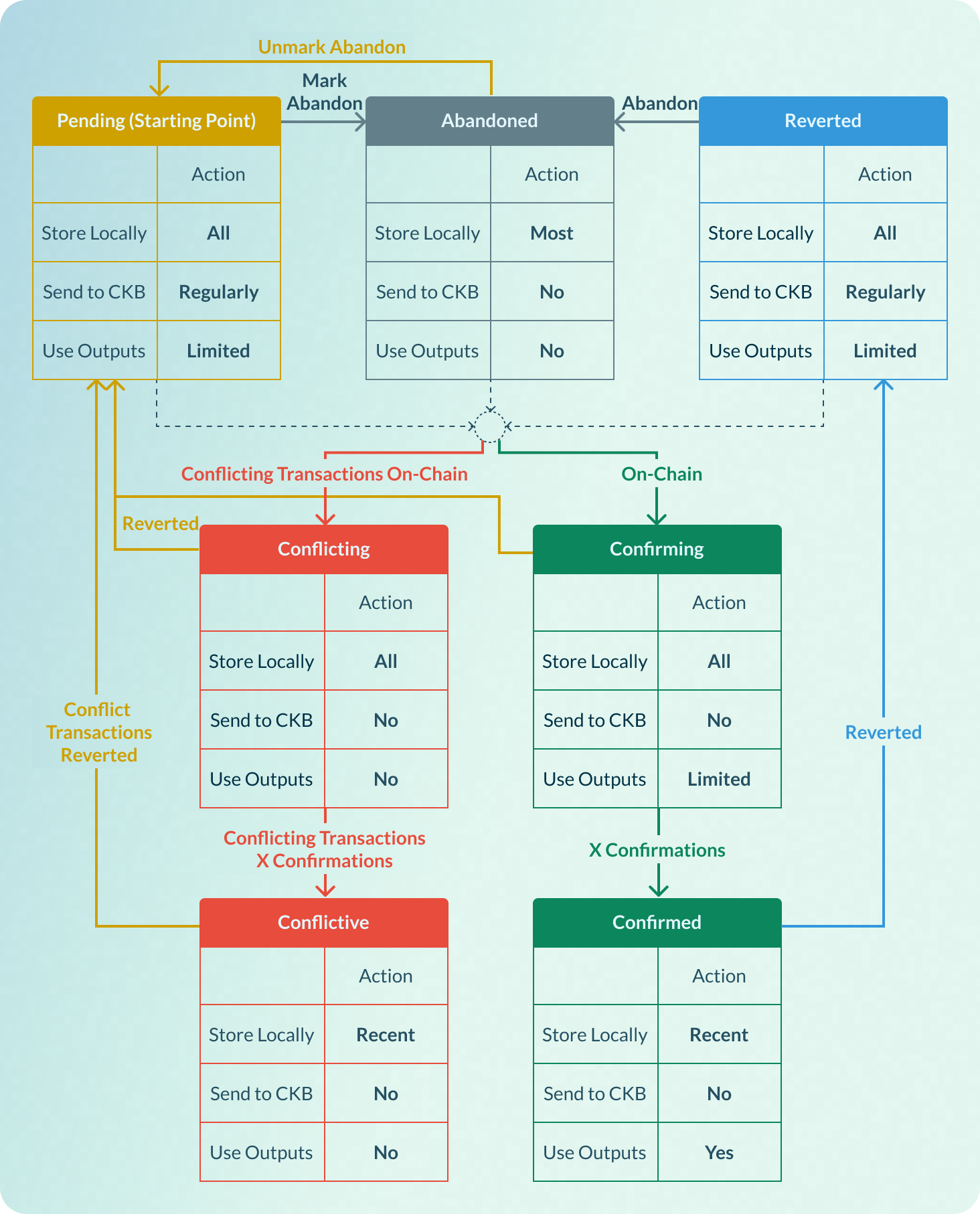Transaction
A transaction in CKB destroys some Cells (outputs from previous transactions) and generates new ones.

Fields & Description
| Name | Type | Description |
|---|---|---|
version | Uint32 | Transaction version distinguishes transactions in the event of a fork. |
cell_deps | [CellDep] | A list of outpoint pointing to the Cells that are dependencies of this transaction. For more, see cell_deps. |
header_deps | [H256(hash)] | A list of H256 hashes pointing to block headers that are dependencies of this transaction. For more, see header_deps. |
inputs | [CellInput] | A list of referenced Cell inputs. For more, see inputs. |
witnesses | [Bytes] | Provided by transaction creator to ensure the successful execution of the corresponding Lock Script. For more, see witnesses. |
outputs | [Cells] | A list of Cells used as outputs, also can be seen as the newly generated Cells. For more, see outputs. |
outputs_data | [Bytes] | A list of Cell data of each output Cell. For more, see outputs_data. |
Example
View Full Transaction
{
"version": "0x0",
"cell_deps": [
{
"out_point": {
"tx_hash": "0xbd864a269201d7052d4eb3f753f49f7c68b8edc386afc8bb6ef3e15a05facca2",
"index": "0x0"
},
"dep_type": "dep_group"
}
],
"header_deps": [
"0xaa1124da6a230435298d83a12dd6c13f7d58caf7853f39cea8aad992ef88a422"
],
"inputs": [
{
"previous_output": {
"tx_hash": "0x8389eba3ae414fb6a3019aa47583e9be36d096c55ab2e00ec49bdb012c24844d",
"index": "0x1"
},
"since": "0x0"
}
],
"outputs": [
{
"capacity": "0x746a528800",
"lock": {
"code_hash": "0x9bd7e06f3ecf4be0f2fcd2188b23f1b9fcc88e5d4b65a8637b17723bbda3cce8",
"args": "0x56008385085341a6ed68decfabb3ba1f3eea7b68",
"hash_type": "type"
},
"type": null
},
{
"capacity": "0x1561d9307e88",
"lock": {
"code_hash": "0x9bd7e06f3ecf4be0f2fcd2188b23f1b9fcc88e5d4b65a8637b17723bbda3cce8",
"args": "0x886d23a7858f12ebf924baaacd774a5e2cf81132",
"hash_type": "type"
},
"type": null
}
],
"outputs_data": [
"0x",
"0x"
],
"witnesses": ["0x55000000100000005500000055000000410000004a975e08ff99fa0001
42ff3b86a836b43884b5b46f91b149f7cc5300e8607e633b7a29c94dc01c6616a12f62e74a1
415f57fcc5a00e41ac2d7034e90edf4fdf800"
]
}
Transaction States
The transaction lifecycle starts after creation and ends when it is finally confirmed or conflicts with a confirmed transaction. During this lifecycle, the transaction must be in one of the following states:
- Pending
- Confirming
- Confirmed
- Conflicting
- Conflictive
- Reverted
- Abandoned
The list excludes orphan transaction that depends on unknown Cells, as transaction generators typically ignore them.
Different states require different strategies as described in the following sections.

Pending Transaction
A newly created transaction starts in the Pending state.
The generator must store pending transactions locally and regularly send them to CKB nodes. It's essential because CKB nodes may drop transactions from their pools.
It is not recommended for the generator to use output Cells of pending transactions unless the transaction is stuck and requires a fee bumping. If chaining pending transactions is unavoidable, limit the chain’s length.
The transaction turns to the Confirming state once it appears in a block on the canonical chain.
If the pending transaction or any of its ancestor transactions1 has conflicting input Cells with a transaction on the canonical chain, it becomes conflicting.
User or Apps can mark a pending transaction as Abandoned, if they decide to give up a stuck transaction.
Confirming Transaction
Transactions in Confirming state are in the chain but have not qualified as Confirmed yet.
The generator must store confirming transactions locally but does not need to send them to CKB nodes regularly.
Same as pending transactions, it is not recommended to use the output Cells of confirming transactions.
The block containing the transaction gives one confirmation. Each descendant block in the chain gives an extra confirmation. Although any block can be reverted theoretically, it is safe to assume that the transaction will never be reverted after a certain number, say X, of confirmations. The confirming transaction becomes Confirmed when it has received at least X confirmations. X depends on various factors. The generator must decide the value of X and adjust it regularly.
If a chain reorganization reverts the block containing the transaction, the transaction reverts to Pending.
Confirmed Transaction
Transactions in Confirmed state are in the chain and has received at least X confirmations.
The generator can remove confirmed transactions from local storage or keep the latest ones as a historical reference.
The generator can freely use the output Cells of confirmed transactions.
If a chain reorganization reverts the block containing the transaction, the transaction becomes Reverted.
Conflicting Transaction
A transaction is in Conflicting state if it conflicts with any transaction in the chain. Two different transactions conflict when:
- They have conflict input Cells;
- A transaction has conflicting input Cells with any ancestor of another transaction;
- They are descendants of a pair of conflict transactions.
The generator must store these conflicting transactions locally, because there is a chance they may become Pending again.
The generator should not use the output Cells of conflicting transactions.
If all blocks containing conflicting transactions have been reverted, the conflicting transactions revert to Pending.
If any conflicting transaction received X confirmations, the conflicting transactions become Conflicted.
Conflictive Transaction
A transaction is in Conflictive state when it conflicts with an on-chain transaction that has received at least X confirmations.
The generator can remove conflictive transactions from local storage, or keep the most recent ones for reference.
The generator should not use the output Cells of conflictive transactions.
If all blocks containing conflicting transactions have been reverted, the conflictive transactions revert to Pending.
Reverted Transaction
Reverted state is an alias of Pending, suggesting that the transaction was once confirmed, but has been reverted.
The generator must store and send reverted transactions regularly. The state transformations are the same as pending transactions.
Abandoned
The generator should allow users to mark a pending or reverted transaction as Abandoned, when they give up the effort to commit it. But due to a timing gap, an abandoned transaction may still be already submitted to a node.
The generator must store a sufficient time range of recent abandoned transactions. Try not to delete transactions that are marked as Abandoned, as they might already be in Pending state.2
Users are allowed to mark an abandoned transaction to Pending.
Transactions can transform from Abandoned to Confirming or Conflicting, like pending and reverted transactions.
Footnotes
-
Transaction A is considered a parent of B, if B uses an output Cell of A as its input Cell. An ancestor is either the parent or an ancestor of any parent. ↩
-
If you want to accelerate the confirmation, consider using RBF fee bumping method that involves creating a new transaction using some or all of the same inputs from an unconfirmed transaction, but with a higher fee. Deleting the abandoned transaction eliminates this option. RBF has been a default feature in CKB since v0.112.1. ↩